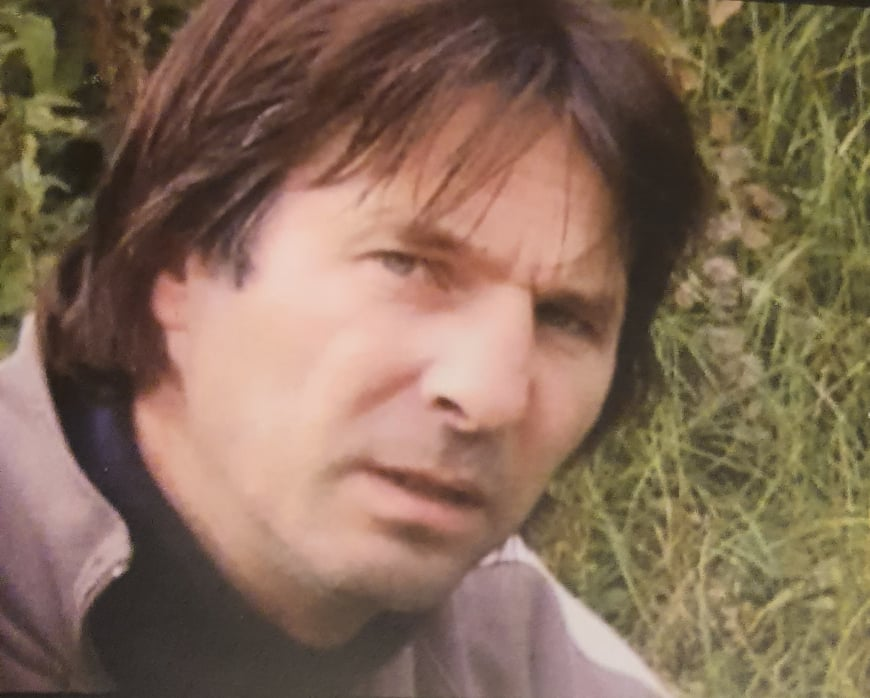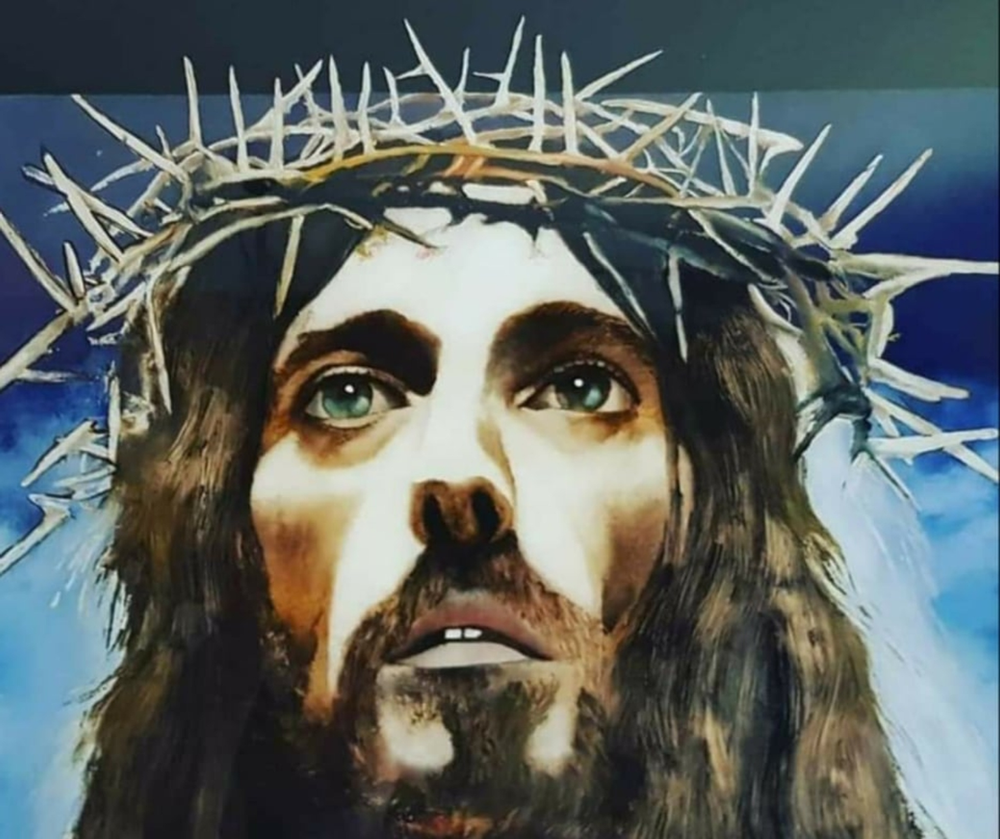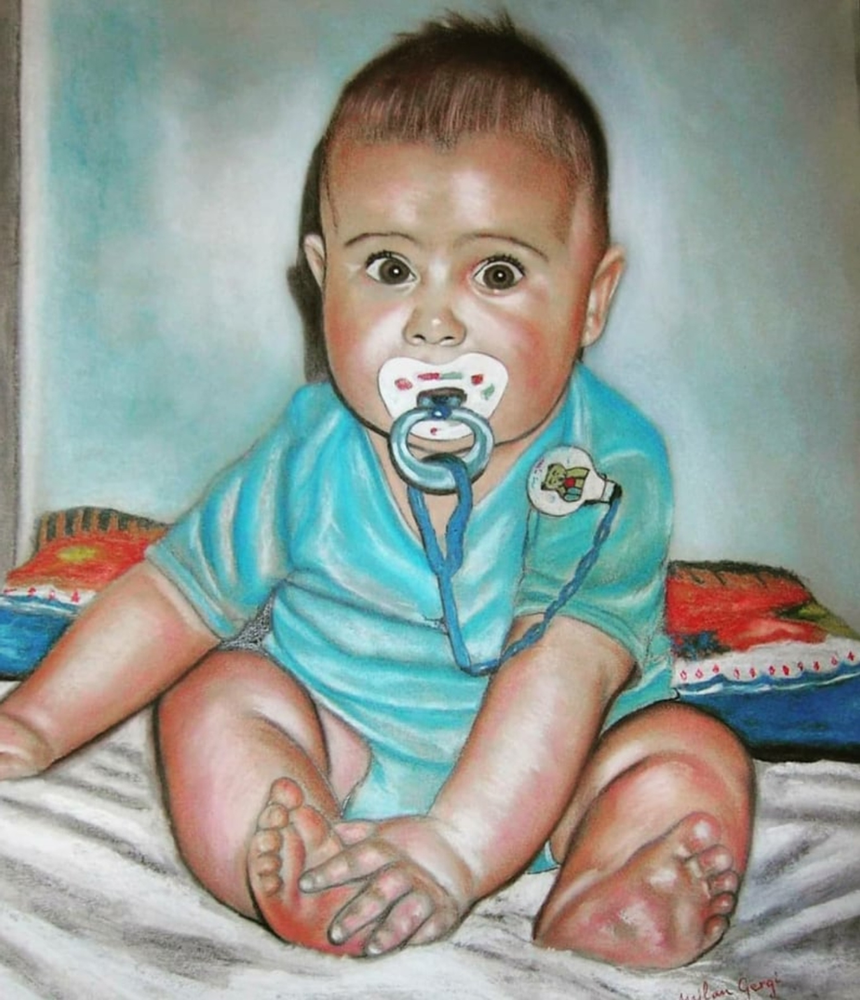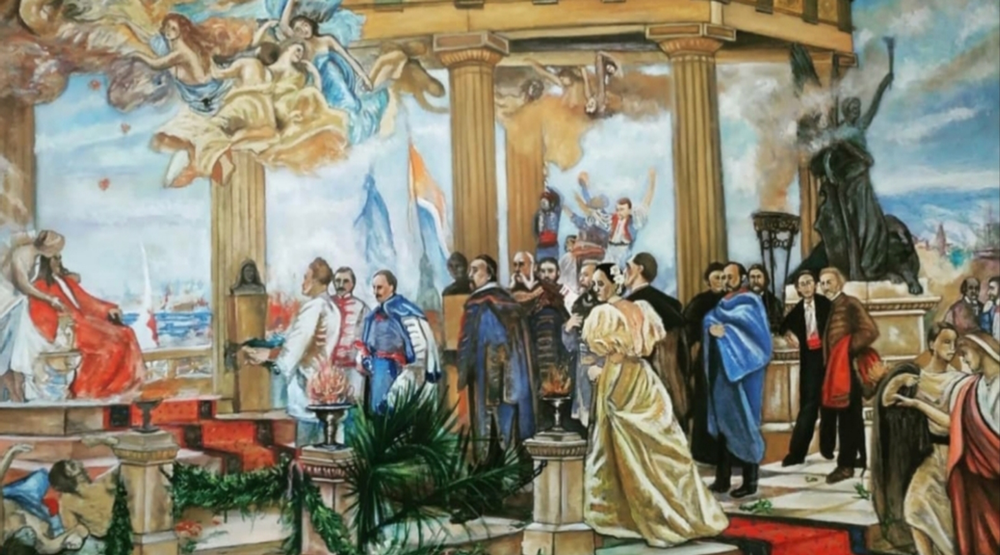
Milan Gergi
Nel percorso di molti artisti esiste un evento, una circostanza verificatasi all’improvviso che costituisce un vero e proprio giro di boa, un cambiamento radicale dopo il quale l’indole espressiva rimasta fino a quel momento latente si manifesta, si delinea rendendosi non solo intuibile bensì inarginabile al punto di indurre il protagonista di quella sensazione a liberarla trovando una dimensione nuova, quella in cui il dono della creatività entrerà per sempre a far parte della sua vita. Questo è quanto accaduto a Milan Gergi, artista croato che ha seguito il suo impulso a fare arte successivamente a un grave incidente dal quale ogni percorso intrapreso in precedenza è stato messo in discussione, modificato per sempre conducendolo verso la strada attuale, quella tutto sommato migliore per l’individuo che aveva scoperto di essere a seguito di quell’accadimento. Inizialmente orientato alla vita religiosa, all’età di venti anni studia teologia come monaco francescano a Zagabria, un grave incidente d’auto avvenuto quattro anni dopo l’inizio di quel suo cammino interiore, lo ha indotto, dopo un lungo periodo di riabilitazione durante il quale ha meditato e riflettuto, a rivedere le sue scelte e a cercare di conciliare il suo amore per la teologia con un approccio differente scegliendo così di condurre una vita laica e diventando insegnante di religione. Quel cambiamento è coinciso anche con la volontà di lasciar fuoriuscire la sua indole creativa, quella che era già un’eredità familiare poiché il padre amava dedicarsi alla scultura nel tempo libero, e che in Milan si è concretizzata invece nella pittura e nell’amore per uno stile classico in cui alterna soggetti religiosi a omaggi a grandi maestri del passato ma anche a volti e persone che colpisce la sua sensibilità. Ciò che emerge chiaramente nelle sue tele è l’attenzione al dettaglio, la minuziosità con cui descrive le scene o i particolari dei volti, il chiaroscuro, l’espressività che contraddistingue persino una natura morta,

Stilleben (Natura morta)
proprio in virtù di quell’armonioso tocco stilistico legato alle regole pittoriche del Rinascimento, del Realismo, del Manierismo, che hanno tracciato i principali percorsi della storia dell’arte. Per quanto riguarda le tecniche che predilige, Milan Gergi si rivela uno sperimentatore poiché spazia dall’olio all’acrilico, su supporto di legno o tela, all’acquerello e al pastello su carta e su cartone; le tonalità scelte sono affini ai soggetti rappresentati, confermando così il suo linguaggio realista, dettagliato pur permeato di romanticismo, di pathos, di intensità emotiva ed espressiva. L’opera Jesus mit Krone (Gesù con corona)

Jesus mit Krone
è simbolica dell’unione delle due anime di Gergi, quella artistica e quella religiosa, attraverso cui riesce a leggere e interpretare l’espressione intensa che traspare dallo sguardo del figlio del Signore, sereno eppure quasi disorientato, consapevole del proprio destino ma al contempo incredulo per la mancanza di comprensione da parte di chi lo aveva giudicato, incline al perdono e tuttavia uomo che si appresta a lasciare la vita terrena; le luci e le ombre sono magistralmente utilizzate dall’artista per infondere intensità al volto scavato ma anche profondità agli occhi limpidi. In Mädchen mit Blumen (Ragazza con fiore),

Madchen mit Blumen
Milan Gergi coglie un momento poetico della ragazza, l’istante in cui china il capo verso il fiore come a volersene lasciar avvolgere, come a ripiegarsi in se stessa per ascoltare un desiderio, un ricordo intimo verso cui quel fiore la riconduce; l’atmosfera circostante è morbida, soffusa, carezzevole, le tonalità delicate e lo stile realista e al tempo stesso romantico proprio in virtù di quella gamma cromatica morbida che la avvolge. Andiamo ora a conoscere meglio questo talentuoso artista.
Milan, il punto di svolta della sua attuale esistenza è stato l’incidente dopo il quale tutto è cambiato; ci racconta qual è stata la spinta più forte verso il cambiamento e quale il momento in cui ha capito che l’arte era una strada da perseguire, un sogno da realizzare?
L’incidente automobilistico ha contribuito in modo significativo alla mia decisione di rinunciare alla sicurezza delle mura del monastero per affrontare nuove sfide con sui sentivo di dovermi misurare. Soprattutto l’arte è nata dall’ascolto di quella naturale inclinazione che non sapevo di avere e che si è trasformata nel mezzo più affine alla rappresentazione del mio mondo. Il mio lavoro artistico attraverso l’espressione creativa è stata una sorta di terapia mentale, una mia preghiera al paradiso, che mi ha ulteriormente nobilitato.
Come mai la scelta di uno stile tanto classico in un’epoca contemporanea nella quale l’imperativo sembra essere l’andare oltre, il distaccarsi dalla realtà o il crearne una nuova attraverso i mezzi virtuali?
Ho scelto lo stile classico poiché era quello che sentivo più affine a me, alla mia libertà e indipendenza di potermi ispirare agli antichi maestri, dal cui stile sono sempre stato influenzato e che vorrei ringraziare con la mia produzione artistica. La pittura è un mezzo statico rispetto al frenetico mondo moderno pieno di immagini in movimento e questo potrebbe indurre a credere che abbia perso il suo predominio, ma la realtà è che non se ne andrà mai, i capolavori e l’espressività della pittura non saranno mai messi in ombra dai nuovi mezzi tecnologici. Nelle mie opere cerco di creare le immagini nel contesto del nuovo tempo per aprire un canale di dialogo del vecchio con il nuovo, e per questa ricerca della piena espressione non escludo i mezzi moderni pur mantenendo forte il mio legame con quelli squisitamente tradizionali.

Kleine Kind (Bambino)
Quanto è importante mantenere il legame con il passato e anche con la nostra parte più spirituale?
La forte connessione con il passato che traspare dal mio modo di fare arte, attraverso l’osservazione ma anche gli omaggi che spesso realizzo alle opere dei maestri di ogni tempo, mi tiene saldamente a terra. È la base di partenza in virtù della quale mantengo il mio equilibrio.
Spesso le sue opere sono omaggi a grandi artisti del passato, ci può dire quali sono quelli che l’hanno ispirata e a quali si sente più legato dal punto di vista stilistico?
È vero, le mie foto sono spesso un monumento ai i vecchi maestri; quelli che hanno costituito i modelli verso cui tendere sono V. Bukovac, M.C. Medovic, F.Kovacevic, G. Klimt, E. Fuchs, Alma-Tadema, Munkacsy, solo per citare i più importanti. Mi interessa molto seguire la linea melodica e poetica dell’Art Nouveau e quel suo particolare simbolismo combinato con il realismo, il cosiddetto realismo, il cosiddetto realismo abbellito. Attualmente mi sto predisponendo a creare un lavoro postmoderno basato sulla simbiosi tra tradizione e modernità.

Illirski Prepod-Hommage an V. Bukovac
Che progetti ha per il prossimo futuro?
Nel prossimo futuro vorrei avere un po’ più di tempo per la mia arte: vorrei provare ad avvicinarmi allo stile delle avanguardie allontanandomi dalla pittura da cavalletto, e cominciare a realizzare anche sculture combinando vecchi materiali con quelli più nuovi e legati alla scultura di metà Novecento come il legno, il metallo, la carta, mettendo in pratica le nuove idee su cui sto meditando da un po’. Poi a luglio parteciperò alla mostra collettiva Vienna Art Summer presso la galleria Publicartists di Vienna.
MILAN GERGI-CONTATTI
Email: milan.gergi.mg@gmail.com
Sito web: http://www.atelier-gergi.at/
Facebook: https://www.facebook.com/milan.gergi
Instagram: https://www.instagram.com/milangergi/
Marta Lock’s interviews:
Milan Gergi, when events lead to art
In the path of many artists, there is an event, a circumstance that occurs suddenly and constitutes a real turning point, a radical change after which the expressive nature that had remained latent until that moment manifests itself, becomes not only intuitable but also unreachable, to the point of inducing the protagonist of that sensation to release it, finding a new dimension, one in which the gift of creativity will become part of his life forever. This is what happened to Milan Gergi, a Croatian artist who followed his impulse to make art after a serious accident, after which every path he had previously taken was called into question and changed forever, leading him towards his current path, the one that is, after all, best for the individual he discovered he was after that event. Initially oriented towards the religious life, at the age of twenty he studied theology as a Franciscan monk in Zagreb, a serious car accident four years after the start of his inner journey led him, after a long period of rehabilitation during which he meditated and reflected, to review his choices and try to reconcile his love for theology with a different approach, choosing to lead a secular life and becoming a religious teacher. That change also coincided with a desire to let his creative nature emerge, which was already a family inheritance since his father loved to devote himself to sculpture in his spare time, and which in Milan took shape instead in painting and in his love for a classical style in which he alternates religious subjects with homages to great masters of the past but also to faces and people that strike his sensitivity. What clearly emerges in his canvases is the attention to detail, the meticulousness with which he describes scenes or the details of faces, the chiaroscuro, the expressiveness that distinguishes even a still life, precisely because of that harmonious stylistic touch linked to the pictorial rules of the Renaissance, Realism and Mannerism, which have traced the main paths in the history of art. With regard to the techniques he prefers, Milan Gergi is an experimenter, ranging from oil to acrylic on wood or canvas, watercolour and pastel on paper and cardboard; the tones he chooses are similar to the subjects represented, thus confirming his realistic language, detailed yet permeated with romanticism, pathos, emotional and expressive intensity. The work Jesus mit Krone (Jesus with a crown) is symbolic of the union of Gergi’s two souls, the artistic and the religious one, through which he manages to read and interpret the intense expression that transpires from the gaze of God’s son, serene yet almost disorientated, aware of his destiny but at the same time incredulous at the lack of understanding on the part of those who had judged him, inclined to forgive and yet a man who is preparing to leave earthly life; lights and shadows are masterfully used by the artist to infuse intensity into the hollow face but also the depth of the clear eyes. In Mädchen mit Blumen (Girl with a Flower), Milan Gergi captures a poetic moment in the girl’s life, the instant in which she bows her head towards the flower as if to let it envelop her, as if turning in on herself to listen to a desire, an intimate memory to which the flower leads her back; the surrounding atmosphere is soft, suffused, caressing, the tones delicate and the style realistic and at the same time romantic precisely because of the soft colour range that envelops her. Let’s go now to know this talented artist better.
Milan, the turning point in your current life was the accident after which everything changed; can you tell us what was the strongest push towards change and what was the moment when you realised that art was a road to pursue, a dream to be realised?
The car accident contributed significantly to my decision to give up the safety of the monastery walls to take on new challenges that I felt I had to face. Above all, art was born out of listening to that natural inclination that I did not know I had, and which became the medium most akin to represent my world. My artistic work through creative expression has been a kind of mental therapy, my prayer to heaven, which has further ennobled me.
Why did you choose such a classical style in a contemporary age in which the imperative seems to be to go beyond, to detach oneself from reality or to create a new one through virtual means?
I chose the classical style because it was the one I felt was closest to me, to my freedom and independence to be able to draw inspiration from the old masters, whose style I have always been influenced by and whom I would like to thank with my artistic production. Painting is a static medium compared to the frantic modern world full of moving images and this might lead one to believe that it has lost its dominance, but the reality is that it will never go away, the masterpieces and expressiveness of painting will never be overshadowed by new technological means. In my artworks, I try to create images in the context of the new time to open a channel of dialogue between the old and the new, and in this search for full expression, I do not exclude modern media while maintaining a strong link with the exquisitely traditional ones.
How important is it to maintain the link with the past and also with our more spiritual side?
The strong connection with the past that is evident in my way of making art, through observation but also through the homages I often pay to the artworks of the masters of all times, keeps me firmly grounded. It is the basis on which I maintain my balance.
Your work often pays homage to great artists of the past, can you tell us which ones inspired you and which ones you feel most attached to from a stylistic point of view?
It is true, my photos are often a monument to the old masters; those who have been the models to strive towards are V. Bukovac, M.C. Medovic, F. Kovacevic, G. Klimt, E. Fuchs, Alma-Tadema, Munkacsy, just to mention the most important ones. I am very interested in following the melodic and poetic line of Art Nouveau and its particular symbolism combined with realism, the so-called Embellished Realism. I am currently preparing to create a postmodern work based on the symbiosis of tradition and modernity.
What plans do you have for the near future?
In the near future I would like to have a little more time for my art: I would like to try to get closer to the avant-garde style by moving away from easel painting, and also start making sculptures by combining old materials with newer ones linked to mid-twentieth-century sculpture such as wood, metal, paper, putting into practice the new ideas I have been meditating on for a while. Then in July I will take part in the Vienna Art Summer group exhibition at the Publicartists gallery in Vienna.
